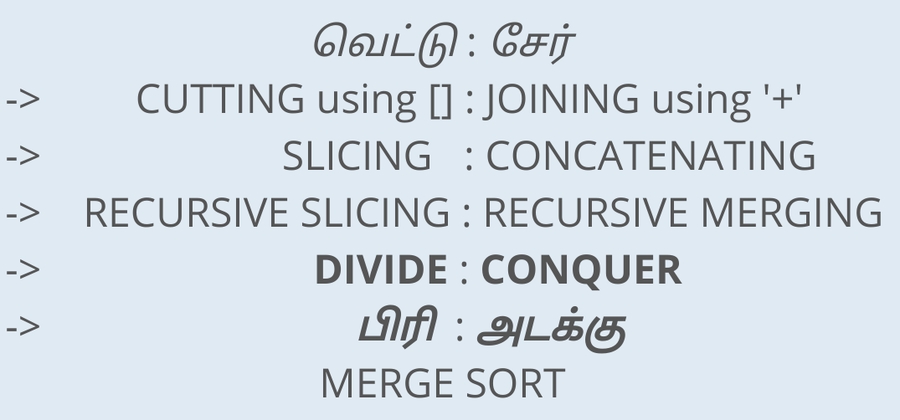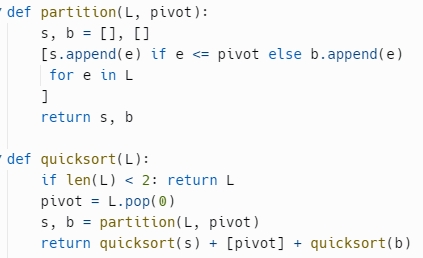cs3003-unit4-examples
Illustrative programs of Tuples, Lists and Dictionaries
Pre-requisites
http://j.mp/insertVisual
http://j.mp/mergeVisual
http://bit.ly/histogramVisual
Recommended sequence
InsertSort -> SelectionSort -> MergeSort -> Histogram
InsertionSort
Pre-requisites
http://j.mp/insertVisual
http://j.mp/interactInsert using
[10, 3, 2, 4, 0, 30, 1, 5, 15]pop()- what does it do? Does it accept any arguments? What doespush()do? Does it accept an argument as well?does
alist.pop()have the same effect asalist.pop(0)?How to use
pop()to remove the last element in the list?How to use
pop()to remove the first element in the list?Assume
alistcontains 4 elements['one', 'two', 'three', 'four', 'zero']. If you execute the following code, what will be the output?alist.pop(0)alist.pop()alist.pop(0)print(alist[-1], alist[0])If
ulistis a non-zero list, what is the difference betweenulist[0]versusulist.pop(0)?Contrast between
del,popandremoveeffect on a listWrite a code snippet which operates on a list and prints every element in it. By the time it is done, the list must be empty.
insert()- what does this do? How many arguments does it accept?write the equivalent of
append()function usinginsert()When
popmethod exists, why is there nopushmethod? Define a suitable list operationpushthat would be perform the role of a listpushmethod if it were to exist.
What will the following snippets do?
Algorithm
In
insertsort, given a key, a copy of a pre-determined element in the list, we insert it at the appropriate location after comparing it with the unsorted elements of the list.
More detailed pseudo-code:
Source code
The following code can be used to test the above code:
Practice insertionsort at http://j.mp/insertionSortCC
The million insert challenge http://j.mp/millionInsert
SelectionSort
Pre-requisites
http://j.mp/selectVisual
http://j.mp/interactSelect using
[10, 3, 2, 4, 0, 30, 1, 5, 15]Which built-in function helps find the minimum element in a list?
What happens when the built-in function is provided with a null list?
If you cannot use
min, write the code for finding the minimum value in a list
What is the method of a list that returns the index for an element in the list?
What is the difference between
findandindex?
how do you iterate over all the elements in a list, except the last one? Write the python code to do this
What is the value of
[1, 2, 3, 4][0:]and[1, 2, 3, 4][1:]and[1, 2, 3, 4][2:]?What is the built-in function which is used to find the minimum value of a list of numbers? Create a list containing 10 random numbers. Write the python code to find the minimum value in the list.
What is the list method to find out the index of a value in a list?
How many arguments does the method accept?
What is the second argument for?
What are the ways you can swap the value in two variables?
What is the most pythonic way to do this?
Find the minimum value in a list and the index of the minimum value. Write a list comprehension as part of the code that returns both values in a tuple.
Write code for swapping two variables without using a temporary variable. If it is not a one line statement, try refactoring whatever you have into one single statement.
In-class Demo
Algorithm
In
selectsort, the position of the update is pre-determined, starting from the beginning of the list. We then go select the maximum value among the unsorted elements of the list, and swap it with the element in the pre-determined location.
Here's an example:
Source code
Version 1
Version 2
Version 3
uses
slicing,tuplesandlist comprehensionto make the code very efficient and eminently readable.
Bonus
Can you improve on the basic selection sort? How about grabbing the maximum value during every iteration and using it?
Practice selection sort at http://j.mp/selectionSortCC
MergeSort
tl;dr
The key thing is to slice into almost two equal halves. That's the crux!
Pre-requisites
List functions
Looping through a list - write code to iterate through the elements in a list
Using indexing
Without using indexing
Using a
whilestatement
Merging
In how many ways can you append two lists?
What does the method
extendperform for a list?
Slicing
Write the code statement to initialize a variable
middlewith the index of the middle element of a list containingnelements.How to get the first 3 elements in the list and create another list out of those elements?
How to get the last 3 elements in a list and create another list of of those elements?
How to get all the elements to the right of the midpoint of a list and place it in another list?
Write a function
sliceInTwowhich accepts a list as argument. It should returns two lists that contain equal number of elements from the original list.
Misc
Provide an example for using the ternary operator in Python
What is the most critical thing that is to be specified in a recursive call so that the program does not run forever?
Ultimate challenge
http://j.mp/sortApply
In-class demo
Visualization
Notice that at each level we divide the array into two halves until we get bunch of single element arrays. This is the divide portion of the divide and conquer method. Then, we start merging and sorting the smaller arrays in a series of steps which is the conquer portion of divide and conquer.

Merge example
Use a 4-element array to explain mergesort - why should it be 8 and so confusing upfront?
With reference to below diagram, how many lists are there in Row 4?
Until what row is Divide happening?
From which row onwards Conquer has begun?
InsertSort and SelectionSort are examples of comparison sorts
However, MergeSort, is an example of the Divide-and-Conquer algorithm sorts
Divide means portioning the n-element array to be sorted into two sub-arrays of n/2 elements. If A is an array containing zero or one element, then it is already sorted. However, if there are more elements in the array, divide A into two sub-arrays, A1 and A2, each containing about half of the elements of A.
Conquer means sorting the two sub-arrays recursively using merge sort. Combine means merging the two sorted sub-arrays of size n/2 to produce the sorted array of n elements.
Algorithm
Means what it sounds like. A divide and conquer algorithm breaks up a problem into smaller sub-problems and solves those, putting the solutions to the sub-problems together to come up with the solution to the total problem.
In
mergesort, a divide-and-conquer partitioning algorithm (which more often requires extra memory), the input array is divided in two halves, calls itself recursively for the two halves and then merges the two sorted halves. Themerge()function is used for merging two halves.
The basic steps in the recursive MergeSort Algorithm is as follows:
Source code
Visualize at http://tinyurl.com/visualMerge
Histogram
http://bit.ly/histogramVisual
Pre-requisites
Histogram
Write a sample code snippet which uses list comprehension to create a list of numbers from 1 to 10
Use the built-in divmod() function to divide 222 by 7 and unpack the quotient and remainder into a tuple, and print the tuple
Create a list that contains all the keys in a dictionary. What is the code?
Create a list that contains all the values in a dictionary. What is the code?
Create a list of tuples from a dictionary that contains all the key:value pairs.
Sort the tuples in the list based on its value in descending order
Write code for both the above.
Can a string be a key in a dictionary? Can a list like
[1, 2, 3]be a key in a dictionary? Why not?Can an integer be a key in the dictionary? Can a tuple like
(5, 10)be a key in a dictionary? Why not?Create a histogram with tuples that represent bins (interval specified by low and high values) of sufficient width and see the typical double peaks that occur in random data
Algorithm
We build a histogram using a dictionary where the keys of the dictionary will be the letters in the string and the associated values for each key will be the number of times that the letter appeared.
What about a letter that does not appear in the string? It will never be placed in the dictionary. By assumption, any key that is not in the dictionary has a count of 0.
Define the function to require one parameter, the string.
Create an empty dictionary of counts.
Iterate through the characters of the string, one character at a time.
Source Code
Version 1
Version 2
A histogram contains bins (lower bound, upper bound), and statistical values are dropped into these bins. Eventually, the histogram is visualized based on the bin counts. This type of histogram is what is used in more statistical analysis.
Complexity Analysis
This needs to be expanded - or even required? - Rajasekaran to discuss
http://bit.ly/complexThis
Epilogue
A speech at the end of a play that serves as a comment on or a conclusion to what has happened.
InsertionSort, SelectionSort and MergeSort algorithms were covered in detail, primarily using a Show-And-Tell approach which is most intuitive. Also, the approach is very effective in engaging students of diverse learning capabilities.
A comparison screenshot of the three sorts in action in "verbose" mode is presented below. The screenshot helps differentiate the three sorting algorithms when they process the same unsorted list as a test case. The curious student will want to trace how the unsorted list becomes a sorted one in each of the three cases.
Verbose Compare
Python Pseudo Code Compare
UPDATE: May 30, 2022 Added bubblesort (for AD3251)

bubblesort: compare adjacent elements and swap, as you iterate the list
insertionsort : get a key and insert it into sorted sublist
selectionsort : select minimum value and swap into sorted sublist
mergesort : divide and merge (conquer) of sorted sublists
quicksort: choose a pivot and partition (divide) into big and small sublists and then combine them
UPDATE: May 30, 2022 Added quicksort (for AD3251)

With the partition function:

Helper functions
Three helper functions (insort, min_index and merge) were written and used in the respective sorting implementation.
These helper functions are very effective in capturing the core of each of the algorithm. Also, they help in presenting the algorithm in an incremental fashion, reducing the cognitive load on the student.
http://j.mp/insortCC
How can you refactor the above function to have only one line of code?
If
iis not provided, how will you default it to an appropriate value?
http://j.mp/indexMinCC
http://j.mp/mergeListCC and http://j.mp/unionListCC
http://j.mp/divideTwo - divide a list into two halves
Other related exercises
http://j.mp/butFirstCC and http://j.mp/butLastCC - iterate over a list
http://j.mp/rightShiftCC - right shift exactly by one position
http://j.mp/swapListCC - swap elements in a list
http://j.mp/enumListCC - manually code out the enumerate function
GIF galore
Which one is which?
Sort 1

Sort 2

Sort 3

Last updated